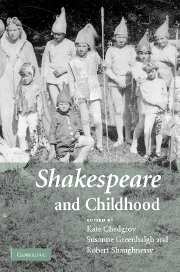Book contents
- Frontmatter
- Contents
- Acknowledgements
- Notes on contributors
- Note on the text
- 1 Introduction
- PART 1 SHAKESPEARE'S CHILDREN
- PART 2 CHILDREN'S SHAKESPEARES
- 8 Introduction: reinventing Shakespearean childhoods
- 9 Play's the thing: agency in children's Shakespeares
- 10 Shakespeare in the Victorian children's periodicals
- 11 Growing up with Shakespeare: the Terry family memoirs
- 12 Shakespeare in the company of boys
- 13 Dream children: staging and screening childhood in A Midsummer Night's Dream
- 14 Shakespeare (')tween media and markets in the 1990s and beyond
- APPENDICES
- Index
8 - Introduction: reinventing Shakespearean childhoods
Published online by Cambridge University Press: 22 September 2009
- Frontmatter
- Contents
- Acknowledgements
- Notes on contributors
- Note on the text
- 1 Introduction
- PART 1 SHAKESPEARE'S CHILDREN
- PART 2 CHILDREN'S SHAKESPEARES
- 8 Introduction: reinventing Shakespearean childhoods
- 9 Play's the thing: agency in children's Shakespeares
- 10 Shakespeare in the Victorian children's periodicals
- 11 Growing up with Shakespeare: the Terry family memoirs
- 12 Shakespeare in the company of boys
- 13 Dream children: staging and screening childhood in A Midsummer Night's Dream
- 14 Shakespeare (')tween media and markets in the 1990s and beyond
- APPENDICES
- Index
Summary
On three pages in a copy of the First Folio held by the Folger Shakespeare Library can be found several children's drawings. They appear as classic examples of juvenile artwork, depicting houses with smoking chimneys (one with a stick-figure in the doorway) and a room complete with table, chairs and pictures on the wall. Although the volume belonged to the same Warwickshire family for several centuries, we do not know whether there is any connection between these drawings and the inscription ‘Elizabeth Okell her book 1729’ which also appears in it, let alone the identity, age or gender of the child (or children) who once found amusement this way. Nor do we know whether the adult response to this youthful self-expression was one of anger or indulgence. We are left simply with the graphic evidence of a meeting point between Shakespeare and childhood, one in which Shakespeare was briefly appropriated and domesticated as part of a child's imaginative world, as a site of childish play.
Here, dealing with an incident that probably took place at some point in the eighteenth century, it might seem that we are at last on familiar ground after the less travelled terrain of early modern childhood studies mapped by Kate Chedgzoy in the introduction to part 1.
- Type
- Chapter
- Information
- Shakespeare and Childhood , pp. 117 - 136Publisher: Cambridge University PressPrint publication year: 2007

